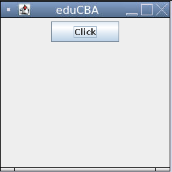
- #JAVA FLOWLAYOUT LOCK VERTICAL HOW TO#
- #JAVA FLOWLAYOUT LOCK VERTICAL CODE#
You can find all of these controls bar one, in your Toolbox under the Containers section as shown in Figure 1.įigure 1 – Standard Container Controls TabControl Now that you know what a Container control’s purpose is, let’s start playing with them, one by one. Container controls can obviously host other Container controls as well then you’re looking at a grandparent, parent and child relationship. The host is known as the parent, and the controls inside the host are known as the children. The Form is the perfect example here, as you put all your controls on the form.
#JAVA FLOWLAYOUT LOCK VERTICAL HOW TO#
Today I will set this record straight with this article and explain exactly what Container controls are, which Container controls are available, and how to use them What are Container Controls?Ĭontainer controls, as their name implies, are controls that can host other controls inside them. It is as if newbies do not realize the true power of a container control.
Are you using a layout manager that can use as much space as is available? See Tips on Choosing a Layout Manager for some tips on choosing a layout manager and specifying that it use the maximum available space for a particular component.Container controls are a misunderstood concept for many a new programmer. Does the component implement the getPreferredSize and getMinimumSize methods? If so, do they return the right values?. Problem: My custom component is being sized too small. You need to invoke revalidate and repaint after adding a component before it will show up in your container. Problem: My component does not appear after I have added it to the container. The BoxLayout manager generally uses a component's preferred size (although components can be larger), and is one of the few layout managers that respects the component's maximum size. The FlowLayout and GridBagLayout managers use the component's preferred size (the latter depending on the constraints that you set), but BorderLayout and GridLayout usually do not. Note: No matter how you specify your component's size, be sure that your component's container uses a layout manager that respects the requested size of the component. If you specify new size hints for a component that is already visible, you then need to invoke the revalidate method on it, to make sure that its containment hierarchy is laid out again. Another way to give size hints is to invoke the component's setMinimumSize, setPreferredSize, and setMaximumSize methods. However, sometimes problems can be encountered with GridBagLayout and text fields, wherein if the size of the container is smaller than the preferred size, the minimum size gets used, which can cause text fields to shrink quite substantially. This is particularly handy for text components, where you might want to fix the width, but have the height determined from the content. Then it can adjust the size, if necessary, before returning it. What is nice about this approach is that each get XxxxSize method can get the component's default size hints by invoking super.get XxxxSize(). If you extend a Swing component class, you can give size hints by overriding the component's getMinimumSize, getPreferredSize, and getMaximumSize methods. Otherwise, you need to provide size hints and then make sure you are using a layout manager that respects the size hints. 
If the component is not controlled by a layout manager, you can set its size by invoking the setSize or setBounds method on it.

For this reason, it often does not make sense to specify a Swing component's exact size. Each Swing component has a different preferred size, depending on the font it uses and the look and feel. Make sure that you really need to set the component's exact size.Check whether the layout manager you are using allows you to specify component sizes. A handful of the more modern layout managers provide ways to override the size set by the component.Problem: How do I specify a component's exact size? If you are interested in using JavaFX to create your GUI, see
#JAVA FLOWLAYOUT LOCK VERTICAL CODE#
Otherwise, if you want to code by hand and do not want to use GroupLayout, then GridBagLayout is recommended as the next most flexible and powerful layout manager. If you are not interested in learning all the details of layout management, you might prefer to use the GroupLayout layout manager combined with a builder tool to lay out your GUI. Note: This lesson covers writing layout code by hand, which can be challenging.






 0 kommentar(er)
0 kommentar(er)
